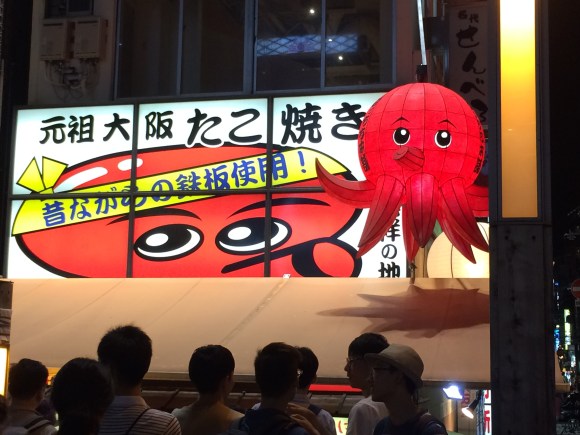
Osaka is famous for Osaka-style okonomiyaki as well as takoyaki. We’ve taught you all about okonomiyaki before, including how to make it at home, and we’ve taken you with us octopus hunting in the Seto Inland Sea where we showed you not only how to catch an octopus, but how to turn its head inside out. So it’s only natural that we feel you are ready to advance your octopial knowledge by exploring what happens to the eight-legged creatures after the catch. Welcome to the wonderful world of takoyaki, battered octopus balls!
Takoyaki is to Osaka what monjayaki is to Tokyo. There’s even a Takoyaki Museum just outside of Universal Studios Japan on the Universal City Walk, with a collection of food stalls where visitors can taste varieties of the snack as well as see the implements used to make it. And since this is Japan, you can also buy numerous takoyaki-inspired souvenirs.
Let’s delve into the delectable world of takoyaki together, after the jump.
The octopus-enhanced treat has its genesis in Osaka, a city that offers free WiFi for travelers and is home to an octopus-loving 2.6 million people. The city, which often seems like one large entertainment district with party-goers descending on the neon-splashed streets in droves, isn’t a part of any of Japan’s 43 prefectures, but instead calls itself a “fu,” or district. In its own right, Osaka has developed a reputation as a place to indulge in the extravagance of food, or more simply put, kuiadore in Japanese. Located on the Seto Inland Sea, Osaka Bay has always been a major port for domestic trading as well as providing a porthole to the Inland Sea from the Pacific. With so much commerce going through its doors, Osaka readily developed into a business-minded community.
So it’s not surprising that one enterprising street vendor, Tomekichi Endo who found himself sampling an akashiyaki treat in Hyogo Prefecture in 1935, hit on the idea to improve upon the dumpling and make a fortune. And he did. He still used octopus as an ingredient, but he changed the akashiyaki recipe from an egg-laced batter to that of a wheat-flour based batter. And wham—takoyaki was born!
▼Endo even used the same mold used to make akashiyaki.
All Endo needed now was octopus tentacles—lots of them! But since each of the sea creatures sports eight legs, and the Seto Inland Sea is a rich source of octopi, he had no problem providing the snack whose popularity expanded to other parts of Japan and spawned takoyaki stalls and restaurants throughout the archipelago.
Another thing that must have helped the popularity of takoyaki is the adaptability of cephalopod caricatures and their kawaii quotient. I mean, it would be a lot harder to sell people a treat based on wild boar hooves, right?
▼ This octopus has, apparently, already sacrificed three of his legs and the Japanese-style hachimaki around his head shows that he is working hard.
▼ You can even make light-up balloons out of octopus. Can’t do that with a wild boar. At least not without scaring everyone.
Another thing that makes takoyaki popular is that it is easy to eat. The bite-sized balls make it convenient to pick up with a toothpick.
▼ Little takoyakis, still in the mold, during the final stage of cooking.
Typically served together in a box, looking a bit like doughnut-holes, makes them portable so they can be taken on picnics, served at festivals, or eaten as regular street food.
▼ Included, on top of the box are wooden chopsticks and a packet of mayonnaise.
▼ The little morsel with a dollop of mayonnaise, looking yummy!
▼After a bite, we can see that they have not forgotten the tentacle. Whew!
Takoyaki is a comfort food for many Japanese people. Children love it, people hoe into it at festivals and with friends, and it’s even served at rest areas off the highway. These days many households have electric takoyaki molds for making the snacks at home.
If you haven’t tried this delightful treat yet, you’re really missing out on the flavor of Osaka. Watch this short video and see how it’s made, and I bet you won’t be able to pass up a takoyaki stall in Japan ever again!
There are many takoyaki stalls and restaurants in Osaka. Let our readers know if you have a favorite!
All images © Amy Chavez/RocketNews24

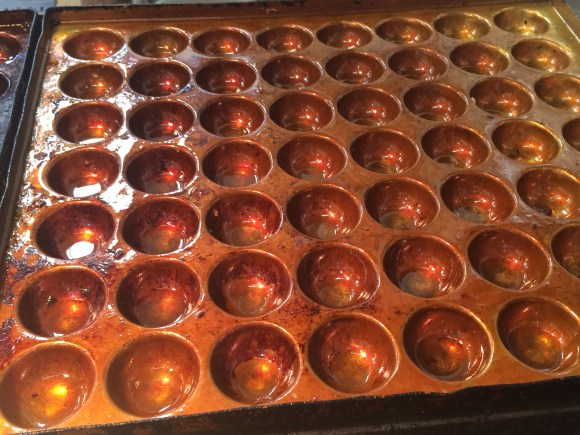
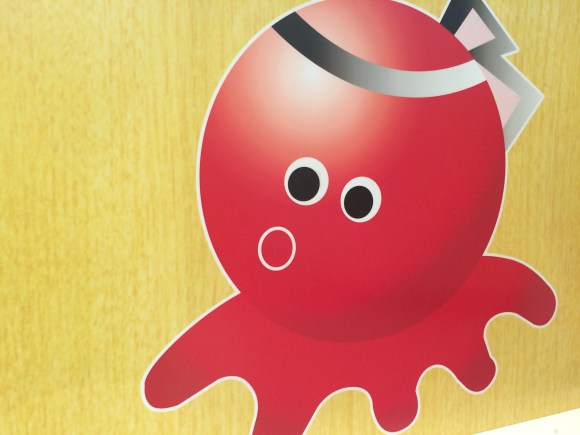
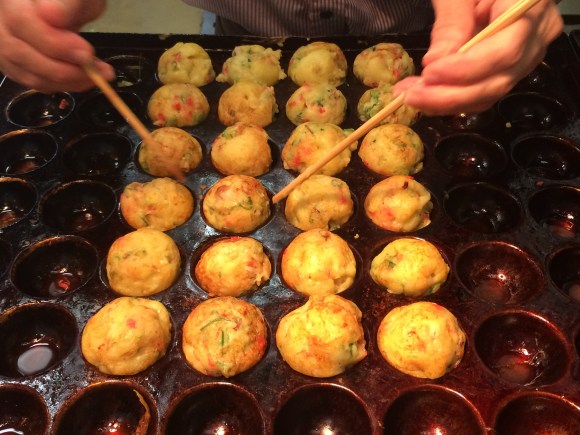
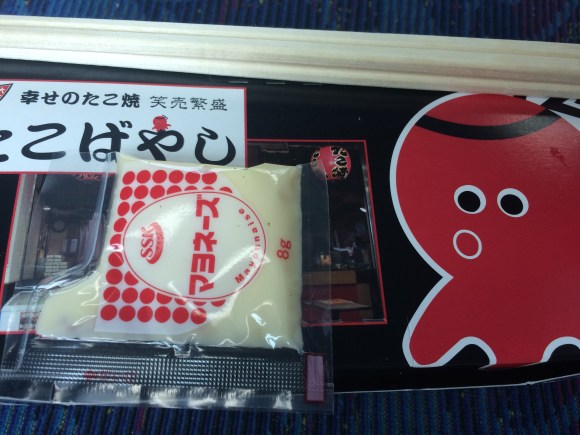
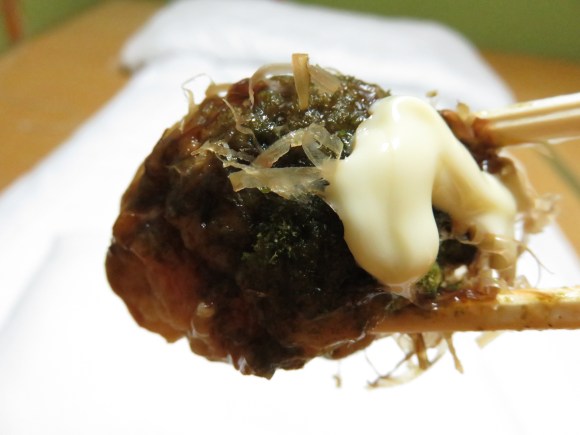
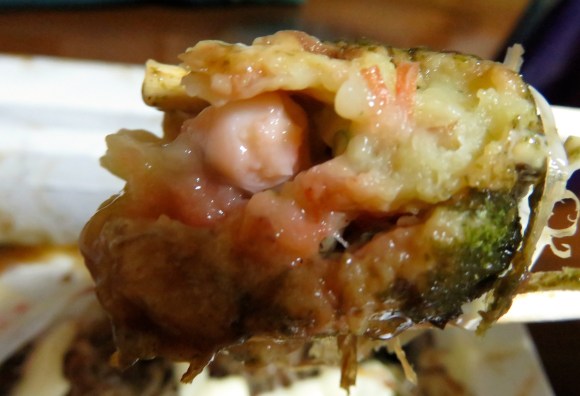
 Talking about takoyaki got us thinking…why can’t you use squid instead of octopus?【SoraKitchen】
Talking about takoyaki got us thinking…why can’t you use squid instead of octopus?【SoraKitchen】 Great balls of octopus and rice! It’s the Takoyaki Onigiri
Great balls of octopus and rice! It’s the Takoyaki Onigiri Octopus balls become octopus planets with amazing tweak to takoyaki recipe
Octopus balls become octopus planets with amazing tweak to takoyaki recipe Our Osaka native taste-tests the extra-expensive, extra-large Bikkuri Takoyaki octopus balls
Our Osaka native taste-tests the extra-expensive, extra-large Bikkuri Takoyaki octopus balls Survey finds that Osaka people don’t eat takoyaki octopus balls as much as you’d think
Survey finds that Osaka people don’t eat takoyaki octopus balls as much as you’d think Starbucks Japan ready to get Year of the Horse started with adorable drinkware and plushies【Pics】
Starbucks Japan ready to get Year of the Horse started with adorable drinkware and plushies【Pics】 7-Eleven Japan’s ramen-cooking robot whipped us up a bowl of noodles【Taste test】
7-Eleven Japan’s ramen-cooking robot whipped us up a bowl of noodles【Taste test】 7 great places to see Mt. Fuji from without having to climb it
7 great places to see Mt. Fuji from without having to climb it This is possibly the coziest train in all Japan thanks to onboard hot spring footbaths【Pics】
This is possibly the coziest train in all Japan thanks to onboard hot spring footbaths【Pics】 Beautiful sightseeing boat is a floating tea ceremony venue in east Japan’s best hot spring town
Beautiful sightseeing boat is a floating tea ceremony venue in east Japan’s best hot spring town Survey finds more than 70 percent of Japanese children have an online friend
Survey finds more than 70 percent of Japanese children have an online friend Gangnam Style Parody “Gaijin Style” Hits the Web With Mixed Reviews
Gangnam Style Parody “Gaijin Style” Hits the Web With Mixed Reviews Japanese avoiding domestic travel as foreign tourists increase, possibly creating vicious cycle
Japanese avoiding domestic travel as foreign tourists increase, possibly creating vicious cycle Stamina-destroying “Paralysis Noodles” are Tokyo’s newest over-the-top ramen innovation
Stamina-destroying “Paralysis Noodles” are Tokyo’s newest over-the-top ramen innovation Waiter, there’re 100 crickets in my soup! We try make-it-yourself Cricket Ramen【Taste Test】
Waiter, there’re 100 crickets in my soup! We try make-it-yourself Cricket Ramen【Taste Test】 Disillusionment at Tsukiji’s tourist-target prices led us to a great ramen restaurant in Tokyo
Disillusionment at Tsukiji’s tourist-target prices led us to a great ramen restaurant in Tokyo Japan may add Japanese language proficiency, lifestyle classes to permanent foreign resident requirements
Japan may add Japanese language proficiency, lifestyle classes to permanent foreign resident requirements Lacquerware supplier to emperor of Japan and Pokémon team up for new tableware
Lacquerware supplier to emperor of Japan and Pokémon team up for new tableware Starbucks Japan releases new zodiac chilled cup drink for 2026
Starbucks Japan releases new zodiac chilled cup drink for 2026 Japan’s otoshidama tradition of giving kids money at New Year’s gets a social welfare upgrade
Japan’s otoshidama tradition of giving kids money at New Year’s gets a social welfare upgrade Cyberpunk anime meets traditional culture in Ghost in the Shell gold leaf Japanese changing screens
Cyberpunk anime meets traditional culture in Ghost in the Shell gold leaf Japanese changing screens Hello Kitty Choco Egg figures are an adorable trip through three periods of Japanese pop culture【Pics】
Hello Kitty Choco Egg figures are an adorable trip through three periods of Japanese pop culture【Pics】 7-Eleven Japan starts new temporary luggage storage service in over 300 branches
7-Eleven Japan starts new temporary luggage storage service in over 300 branches Can a dirty butthole make you filthy rich in Japan? We’re starting a New Year’s lottery experiment
Can a dirty butthole make you filthy rich in Japan? We’re starting a New Year’s lottery experiment Japan’s human washing machines will go on sale to general public, demos to be held in Tokyo
Japan’s human washing machines will go on sale to general public, demos to be held in Tokyo Starbucks teams up with 166-year-old Kyoto doll maker for Year of the Horse decorations【Photos】
Starbucks teams up with 166-year-old Kyoto doll maker for Year of the Horse decorations【Photos】 Tokyo considering law requiring more trash cans following litter increase in heavily touristed area
Tokyo considering law requiring more trash cans following litter increase in heavily touristed area Tokyo’s Tsukiji sushi neighborhood asks tour groups to stay away for the rest of the month
Tokyo’s Tsukiji sushi neighborhood asks tour groups to stay away for the rest of the month Nintendo’s Kirby now delivering orders at Kura Sushi restaurants, but not in Japan
Nintendo’s Kirby now delivering orders at Kura Sushi restaurants, but not in Japan Tokyo event lets you travel back in time, for free, to celebrate 100 years since Showa era start
Tokyo event lets you travel back in time, for free, to celebrate 100 years since Showa era start Sanrio theme park in Japan announces plans to expand into a Sanrio resort
Sanrio theme park in Japan announces plans to expand into a Sanrio resort Survey asks foreign tourists what bothered them in Japan, more than half gave same answer
Survey asks foreign tourists what bothered them in Japan, more than half gave same answer Japan’s deadliest food claims more victims, but why do people keep eating it for New Year’s?
Japan’s deadliest food claims more victims, but why do people keep eating it for New Year’s? We deeply regret going into this tunnel on our walk in the mountains of Japan
We deeply regret going into this tunnel on our walk in the mountains of Japan Studio Ghibli releases Kodama forest spirits from Princess Mononoke to light up your home
Studio Ghibli releases Kodama forest spirits from Princess Mononoke to light up your home Major Japanese hotel chain says reservations via overseas booking sites may not be valid
Major Japanese hotel chain says reservations via overseas booking sites may not be valid Put sesame oil in your coffee? Japanese maker says it’s the best way to start your day【Taste test】
Put sesame oil in your coffee? Japanese maker says it’s the best way to start your day【Taste test】 The top 10 annoying foreign tourist behaviors on trains, as chosen by Japanese people【Survey】
The top 10 annoying foreign tourist behaviors on trains, as chosen by Japanese people【Survey】 No more using real katana for tourism activities, Japan’s National Police Agency says
No more using real katana for tourism activities, Japan’s National Police Agency says Starbucks Japan reveals new sakura drinkware collection, inspired by evening cherry blossoms
Starbucks Japan reveals new sakura drinkware collection, inspired by evening cherry blossoms New cookbook turns the uni-tasker takoyaki maker into a versatile multi-tasker
New cookbook turns the uni-tasker takoyaki maker into a versatile multi-tasker Attention home takoyaki chefs! Japan now has a specialty store for takoyaki flour【Taste test】
Attention home takoyaki chefs! Japan now has a specialty store for takoyaki flour【Taste test】 Let’s try again: Why can’t we make takoyaki with squid instead of octopus?
Let’s try again: Why can’t we make takoyaki with squid instead of octopus? Takoyaki store in Tsukiji serves up dried bonito flakes even bigger than the octopus balls
Takoyaki store in Tsukiji serves up dried bonito flakes even bigger than the octopus balls Wendy’s First Kitchen to sell octopus ball burgers to celebrate Osaka
Wendy’s First Kitchen to sell octopus ball burgers to celebrate Osaka Akashiyaki: A regional dumpling with a fascinating backstory
Akashiyaki: A regional dumpling with a fascinating backstory World’s first Takoyaki Guitar created in Japan, features a gas grill and octopus balls
World’s first Takoyaki Guitar created in Japan, features a gas grill and octopus balls Sausage stepping in for increasingly expensive octopus at takoyaki stands around Japan
Sausage stepping in for increasingly expensive octopus at takoyaki stands around Japan “Flat Takoyaki” at Nanpuu reimagines Japanese street food
“Flat Takoyaki” at Nanpuu reimagines Japanese street food Pringles in Japan come in special souvenir packs featuring the flavour of takoyaki octopus balls
Pringles in Japan come in special souvenir packs featuring the flavour of takoyaki octopus balls Mr. Sato taste tests not only the original takoyaki, but its predecessor, radioyaki, in Osaka
Mr. Sato taste tests not only the original takoyaki, but its predecessor, radioyaki, in Osaka Real takoyaki is almost impossible to find in Tokyo, but this place has it, our hardliner says
Real takoyaki is almost impossible to find in Tokyo, but this place has it, our hardliner says Chocolate takoyaki?? We try the limited-edition sweet that looks just like fried octopus balls
Chocolate takoyaki?? We try the limited-edition sweet that looks just like fried octopus balls Black “Ninja Takoyaki” is Japan’s latest must-try cuisine from Osaka
Black “Ninja Takoyaki” is Japan’s latest must-try cuisine from Osaka Are you Team Taiyaki or Team Takoyaki? – Weighty Food Debate, Street Food Snack Edition
Are you Team Taiyaki or Team Takoyaki? – Weighty Food Debate, Street Food Snack Edition We miss out on cheap all-you-can-eat takoyaki, but stuff ourselves with octopus balls anyway
We miss out on cheap all-you-can-eat takoyaki, but stuff ourselves with octopus balls anyway
Leave a Reply